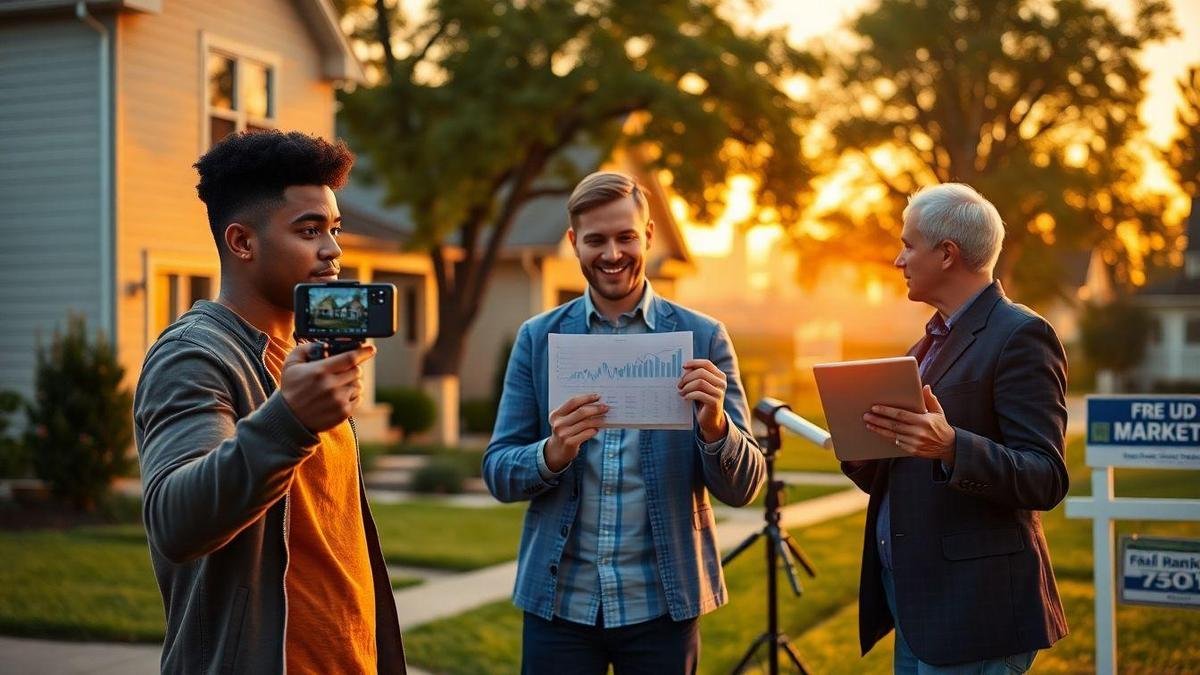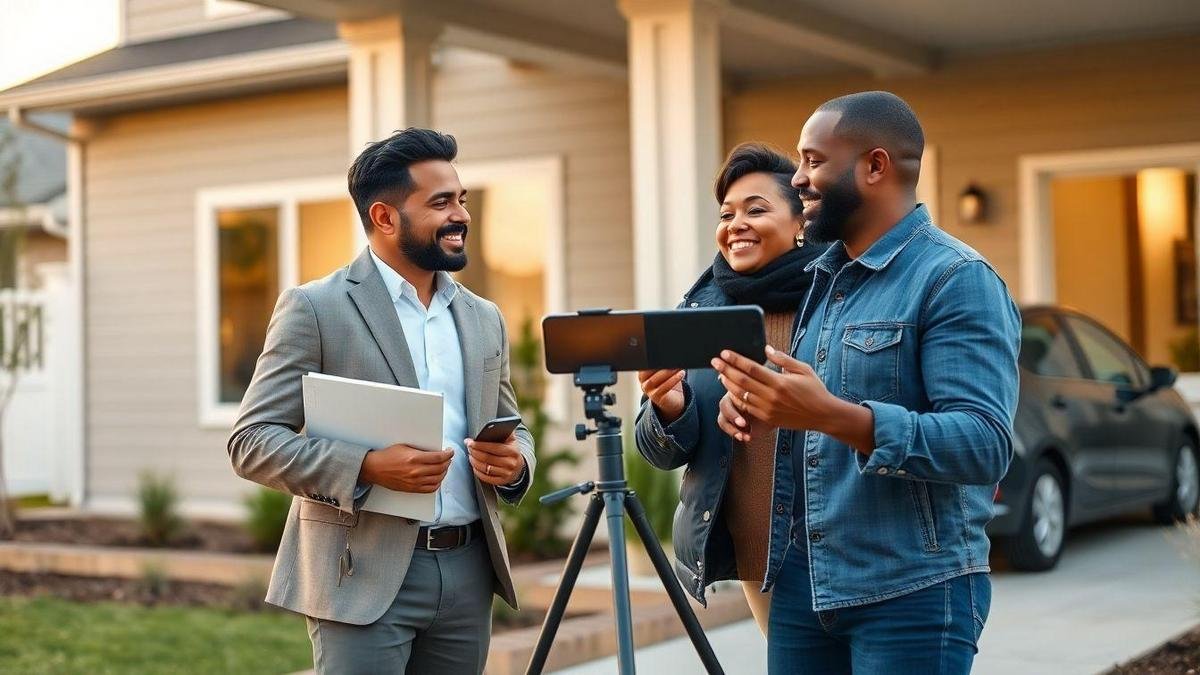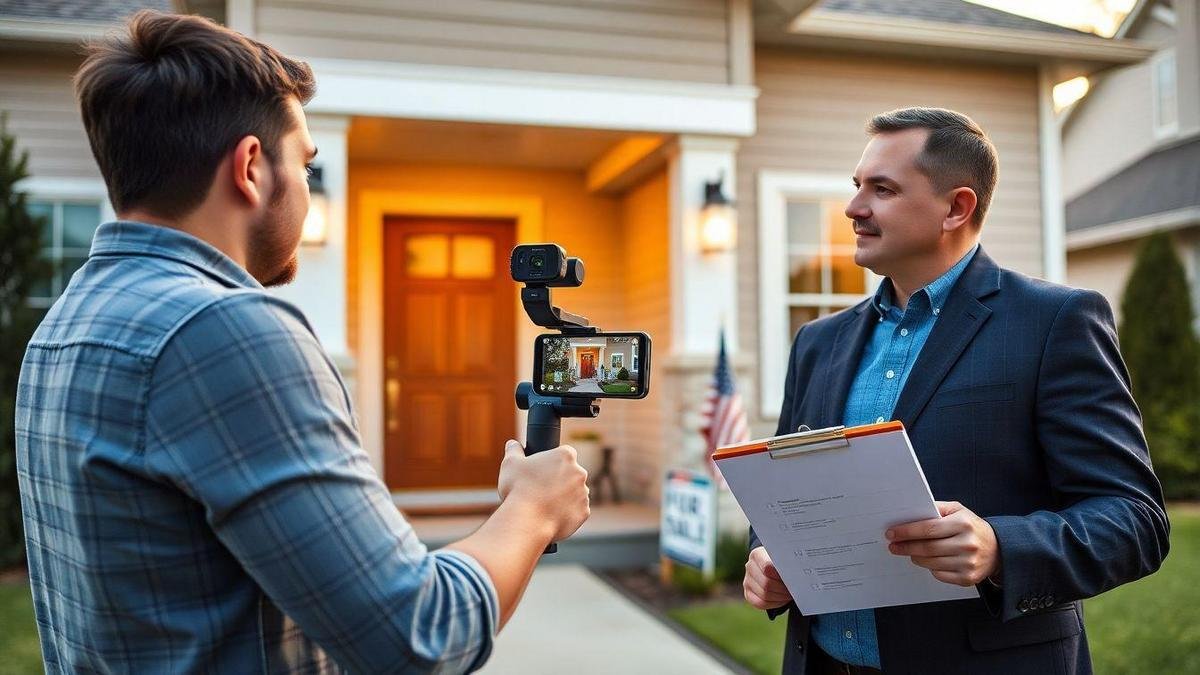
Real estate influencer marketing in the US — a concise guide
Real estate influencer marketing in the US shows agents how to read audience habits on social channels, track platform growth by age, measure ROI, vet partners, use micro-influencers for local listings, run influencer open-house campaigns, write solid contracts, and stay FTC compliant.
Key takeaways
- Choose local influencers with engaged audiences.
- Add clear ad labels on every sponsored post.
- Track leads and sales to measure ROI — tie metrics back to a clear real estate marketing ROI framework.
- Match influencer content to the brand voice and broader branding strategy.
- Set clear goals and budgets before campaigns.
Market trends in real estate influencer marketing in the US
Agents and teams watch Real estate influencer marketing in the US move fast: creators turn property tours into short, shareable stories that change how buyers discover listings. Short videos act like a virtual open house, and strong engagement often turns into real leads — a tactic that pairs tightly with proven real estate video marketing strategies.
How agents read audience habits on social channels
- Younger viewers favor short clips; older buyers read captions and check links.
- Trust grows when influencers show real neighborhoods, not staged shots — sometimes supported by lifestyle visuals or aerial angles from drone photography.
- Back-and-forth comments build credibility; creators become a trusted guide for buyers.
Quick signals:
- Short videos get fast attention.
- Comments drive conversations and appointments.
- Local knowledge wins more leads than glossy production.
Growth data by platform and age group
Platforms serve different buyer segments:
| Platform | Strongest age group | Typical use |
|---|---|---|
| TikTok | 18–34 | Short, high-energy tours and trends |
| 18–44 | Reels, stories, local highlights | |
| 35 | Community posts, marketplace listings | |
| YouTube | 25–55 | Long-form tours, neighborhood guides |
Agents see steady growth in short-video formats across ages. Adding local facts or price context turns casual viewers into qualified inquiries — and platform-specific tactics are covered in broader social media marketing for realtors guidance.
Key data sources
- Platform analytics (reach, watch time, clicks)
- Local MLS trends (listing views, open-house traffic)
- Consumer surveys (preferences by age)
- Creator case studies (what worked in similar markets) — often used within long-form content strategies like content marketing for real estate
Track analytics weekly to tell if a creator is a one-off or a steady lead source.

Measuring ROI for real estate influencer marketing in the US
Metrics agents track for leads and sales
Critical metrics:
- Impressions / Reach — how many saw the content
- Engagement Rate — likes, comments, saves
- Click-Through Rate (CTR) — clicks to listing/landing page
- Leads Generated — contacts from the campaign
- Lead Quality — pre-qualified or ready-to-buy leads
- Conversion Rate — leads → closed deals
- Cost per Lead (CPL) / Cost per Sale
- Revenue Attributed / ROI
| Metric | What it shows | Quick tip |
|---|---|---|
| Impressions / Reach | How many saw the post | Check platform breakdown |
| Engagement Rate | Audience interest | High engagement ≠ sales, but helpful |
| CTR | Traffic to listings | Use clear CTAs |
| Leads Generated | New contacts | Track source tags |
| Lead Quality | Likelihood to convert | Add qualification questions |
| Conversion Rate | Leads → closed deals | Use consistent attribution |
| CPL / Cost per Sale | Spend efficiency | Compare across campaigns |
| ROI | Net return | Include offline sales too |
Example: $3,000 spend → 30 leads (CPL = $100). If 3 closed → conversion 10%, cost per sale $1,000.
Attribution and formulas
- CPL = Total Campaign Spend ÷ Number of Leads
- Conversion Rate = Number of Sales ÷ Number of Leads × 100
- Cost per Sale = Total Campaign Spend ÷ Number of Sales
- ROI (%) = (Revenue Attributed − Total Spend) ÷ Total Spend × 100
Test attribution windows: first-touch, last-touch, and multi-touch each change reported ROI. For practical ROI frameworks and examples, see real estate marketing ROI guidance.
Tools used for ROI measurement
Mix platform data, tracking links, and CRM records:
- Google Analytics UTM tags
- Platform Social Insights (Instagram, Facebook, TikTok)
- CRM systems (HubSpot, Salesforce, etc.) — choose a system that fits your workflow; comparisons include options for land and development teams in the best CRM for land developers overview.
- Tracking Pixels, Call Tracking, link shorteners
- Dashboards / Spreadsheets to combine data
Typical flow: influencer post with UTM → Google Analytics records visit → CRM captures lead → pixel notes form submissions → dashboard shows CPL, conversion, ROI. For retargeting and attribution best practices, combine these with real estate retargeting campaigns.

Finding and vetting property influencer partnerships in the US
Steps to check follower quality
Audit the audience for authenticity and relevance:
- Verify follower count vs. engagement
- Check comment quality and reply patterns
- Inspect audience location and interests
- Ask for a media kit and past campaign reports
| Metric | What it shows | Red flag |
|---|---|---|
| Like-to-follower ratio | Active interest | Very low ratio (<1%) |
| Comment depth | True interest | Generic or repeated comments |
| Follower growth pattern | Organic growth | Sudden spikes/drops |
| Audience location | Market fit | Mostly out-of-market followers |
If an influencer has 50k followers but 200 likes, ask for proof of real leads or skip.
Engagement signals vs. fake followers
Strong signals:
- Consistent likes, meaningful comments, story views matching post engagement, saves/shares, DMs about listings.
Fake signs:
- Very low engagement for follower size, generic comments, sudden follower jumps, accounts with no profile photos, commenter accounts that post nothing.
Use third-party tools and manual audits; supplement vetting with broader digital marketing checks and request past performance reports. Ask for three recent campaign reports—hesitation is a red flag.

Real estate micro-influencers US: when agents should use them
Benefits for local listings
Micro-influencers reach a local crowd quickly, often driving higher engagement and more trusted recommendations. They’re a cost-effective way to amplify open houses and neighborhood stories. In Real estate influencer marketing in the US, micro creators highlight features buyers care about—schools, cafes, street life—generating real showing traffic.
How to select niche creators
Match creators to the neighborhood and buyer profile:
- Map the buyer profile
- Find creators whose followers match that profile
- Review tone and quality of recent posts
- Check engagement on similar posts, not just follower count
- Confirm deliverables, timeline, and disclosure requirements
| Selection criteria | Look for | Red flag |
|---|---|---|
| Audience fit | Followers live/shop in the area | Mostly out-of-area |
| Content style | Matches property tone | Low-quality images |
| Engagement | Comments/saves on local posts | High followers, low interaction |
| Professionalism | Clear rates and posting plan | Missed deadlines, vague terms |
Start with a small paid trial (one story or reel) to test performance and measure against lead tools such as those listed in real estate lead generation tools.
Engagement benchmarks
| Follower tier | Common engagement rate | Typical outcomes |
|---|---|---|
| 1k–10k | 3%–8% | Strong local buzz, DM leads |
| 10k–50k | 2%–6% | Broader reach, more show inquiries |
| 50k–100k | 1%–4% | Wide visibility, fewer personal replies |
Track story view rate, saves, shares, and direct messages to measure real impact.

Real estate influencer outreach strategies for agents
Craft a clear pitch
A short, direct pitch opens doors. Lead with research and value—what the influencer gains.
Pitch checklist:
- Research name, audience, recent work
- One-line value proposition
- Simple campaign idea with deliverables and timing
- State compensation options: flat fee, commission, or trade
- Close with a single call to action
Example hook: “Loved your city tours — want to co-host an open house?” Mention local market context and how the partnership fits broader digital marketing strategies. Micro-influencers often bring higher engagement per follower and better local leads.
Templates (customize with real details)
Email (initial):
Subject: Quick collab idea for [City listing]
Hi [Name], I loved your [post]. A short live tour of a [neighborhood/property type] would fit your audience. We can offer [compensation] and cross-promotion. Free for a 10‑minute call this week? — [Agent]
DM (short):
Hi [Name], loved your [post]. Paid 30‑minute live walkthrough idea for [neighborhood]. Interested? Reply and I’ll share details.
Proposal (after interest):
Thanks for replying. Proposed: one 30‑minute live tour two Reels three Stories within one week. Fee: [amount] or trade. Agency may use clips for ads for 30 days. OK? I’ll send a simple contract.
For outreach templates and nurture sequences, combine these messages with targeted email follow-ups from an email marketing for real estate playbook.
Follow-up timing
- Day 0: initial outreach (friendly, concise)
- Day 3: first follow-up (brief, add one new detail)
- Day 7: second follow-up (polite nudge)
- Day 14: final follow-up (open-ended option)
Keep follow-ups under three messages unless the influencer shows interest; reply within 24 hours to any response.

Social media marketing for realtors US: platform-specific tactics
Best content types
| Platform | Best content types | Why it works | Quick notes |
|---|---|---|---|
| Reels, carousel posts, Stories | Visual discovery; Reels drive reach | Vertical video, captions, location tags | |
| TikTok | Short-form video, neighborhood tips | Fast, playful, viral | Sound-driven, 15–60s ideal |
| Listing posts, live open houses | Local groups, older buyers | Event posts, link previews |
Mix emotional hooks (short tours) with helpful facts (floor plans, prices). Use clear CTAs: book a tour or message for details. In Real estate influencer marketing in the US, Reels and TikTok pair naturally with local creators—always require disclosure for sponsored content. For platform tactics and long-form strategy, see video marketing strategies and broader social media guidance.
Paid ads organic mix
- Start with organic posts to warm the audience.
- Use paid ads to amplify and retarget viewers who watched tours or visited listing pages.
- Track leads, CTR, and video completions; iterate weekly.
Campaign stages:
- Awareness: Boost Reels/TikToks, partner with local creators
- Consideration: Retarget viewers with carousel ads, lead magnets
- Conversion: Ads with direct CTA, appointment links, lead forms
Combine ads and creator posts with retargeting workflows described in real estate retargeting campaigns.
Platform rules and content policies
- Meta (Facebook/Instagram): Use the Special Ad Category for housing; avoid discriminatory targeting.
- TikTok: Disclose sponsored posts; use licensed music.
- Copyright: use platform libraries or licenses.
- Sponsored content: include clear disclosures like “Sponsored” or “Paid partnership.”
Keep copies of permissions and ad creatives to reduce issues if an ad is questioned.

Influencer campaigns for open houses in the US: formats that work
Formats that convert
- Live tours (15–45 min): real-time Q&A, trust-building — test tech and pick a local host. For framing and storytelling, pair live tours with short highlight clips from video marketing playbooks.
- Story takeovers: snackable behind-the-scenes, great the day before and morning of an open house.
- Short-form videos (15–90s): shareable clips that drive long-tail discovery.
| Format | Best platform | Length | Main benefit | Agent role |
|---|---|---|---|---|
| Live tours | Instagram/TikTok Live, Facebook | 15–45 min | Real-time Q&A | Host logistics, guest flow |
| Story takeovers | Instagram Stories | 15–60s per slide | Urgency, FOMO | Prep content, approve script |
| Short-form videos | TikTok, Reels | 15–90s | Shareable reach | Provide shots, brand message |
Prepare a shot list and brief script; rehearsals pay off if influencer is new to property tours — include visual plans that may use drone or staged shots from drone photography guidelines.
Promotion timing & targeting
- 72–48 hrs before: feed post by influencer — reach local followers
- 24 hrs before: stories countdown — build urgency
- Day of: live reminder final story — maximize turnout
Use influencer audience data (age, city, interests); ask for geo-tags and local hashtags. Micro-influencers with tight local followings often deliver better foot traffic than large creators.
Compensation options: flat fee, commission, trade, or hybrid—pick what matches budget and goals.
Safety & on-site procedures
- RSVPs and digital sign-in to limit numbers
- Collect IDs and contact info for follow-up
- Staff on site to guide influencer/guests
- Secure valuables, set video/photo release language
- Confirm insurance and contracts; have an emergency plan

Realtor–influencer collaborations US: contract terms and fee models
Common payment structures
- Flat fee — predictable for clear deliverables
- Performance fee — tied to leads or closed deals (needs tracking)
- Revenue share / commission — percentage of a sale or referral fee
- CPM / CPL — impressions or verified leads
- Hybrid — base fee performance bonus
- Barter — services or product exchange for content
| Model | Best for | Pros | Cons |
|---|---|---|---|
| Flat fee | Short campaigns | Predictable | No performance link |
| Performance | Lead-driven goals | Pay for results | Needs tracking |
| Commission | Sales-focused | Strong alignment | Complex payouts |
| CPM / CPL | Awareness / lead volume | Scalable | Risk of low-quality leads |
| Hybrid | Mixed goals | Shared risk | More contract detail |
| Barter | Local partnerships | Low cash outlay | Hard to value fairly |
Choose a model that matches the campaign and require tracking/reporting before signing — leverage lead generation tools and CRM reporting to enforce performance terms.
Defining deliverables, timelines, and usage rights
Contracts should include:
- Deliverables: post types, counts, captions, tags, CTAs
- Timelines: draft dates, posting window, revision schedule
- Usage rights: where, duration, and geographic limits for reuse
- Exclusivity: whether influencer avoids competing agents
- Disclosure: required sponsorship language per FTC
| Element | What to state |
|---|---|
| Deliverables | Types, counts, format specs |
| Timeline | Drafts, edits, posting window |
| Usage rights | Platforms, duration (e.g., 12 months) |
| Exclusivity | Competitor categories/timeframe |
| Disclosure | Exact label language for paid posts |
Include approval processes, termination terms, indemnity, performance metrics, confidentiality, and insurance requirements. Review with legal counsel and align compensation with tracking methods from ROI models.

FTC guidelines for real estate influencer marketing in the US — compliance basics
Real estate influencer marketing in the US must follow FTC rules on disclosures, record keeping, and penalties.
Disclosure rules
- Material connections must be clearly disclosed.
- Use plain, prominent labels: “Ad,” “Sponsored,” “Paid partnership.”
- In video, disclose early and both spoken and on-screen.
- Hiding disclosures in hashtags or comments is not acceptable.
- Affiliate links and free products also require disclosure.
| Platform | Acceptable disclosure | Unacceptable disclosure |
|---|---|---|
| Instagram post | “Sponsored by ABC Realty” at start of caption | Hidden hashtags at end |
| Instagram Story | “Ad — ABC Realty” on screen | Small unreadable sticker |
| TikTok / Reels | Spoken: “This video is sponsored” on-screen text | Only a tag in a pinned comment |
| YouTube | “Paid endorsement by ABC Realty” in first 5s description | Only in description bottom |
Record keeping & audits
Keep:
- Contracts, post copies (screenshots/videos), proof of disclosure
- Invoices, campaign briefs, approval notes, analytics, communications
Store records for several years and set a clear retention policy.
Penalties & prevention
FTC actions can include refunds, corrective ads, fines. Prevent issues by:
- Using bold, prominent disclosure text
- Building disclosure language into contracts
- Training influencers and staff on material connections
- Approving posts before they go live
- Archiving screenshots immediately after posting
Treat disclosures like a stop sign—obvious and impossible to miss.
FAQ — Real estate influencer marketing in the US
Q: How much budget should an agent allocate?
A: Start small: a trial story or Reel ($100–$1,000 depending on market). Track CPL and conversion to scale using ROI frameworks in real estate marketing ROI.
Q: When should I use micro-influencers vs. macro?
A: Use micro-influencers for tight local reach and higher engagement; use macro creators for broad awareness.
Q: How do I attribute offline sales to influencer activity?
A: Use UTM links, tracking pixels, CRM tags, and call tracking; combine those with retargeting flows outlined in retargeting campaigns and lead tools from lead generation tools. Set an attribution window that matches your sales cycle.
Q: What’s the fastest way to test an influencer?
A: Run one paid story or Reel with clear tracking (UTM lead form). Measure visits, DMs, and booked showings.
Conclusion
This guide gives agents a practical roadmap to turn social attention into showings and sales. Key actions:
- Choose local influencers and micro-creators for neighborhood fit.
- Demand clear disclosures and store records.
- Measure ROI with tracked links and CRM data (CPL, conversion rate, cost per sale).
- Start small, test attribution windows, iterate weekly, and scale what works.
Match fit to neighborhood, measure what matters, and lock terms in a clear contract. Do that, and Real estate influencer marketing in the US becomes a reliable tool—not a gamble.
For additional templates, tactics, and tools, explore more resources on the site.

No responses yet